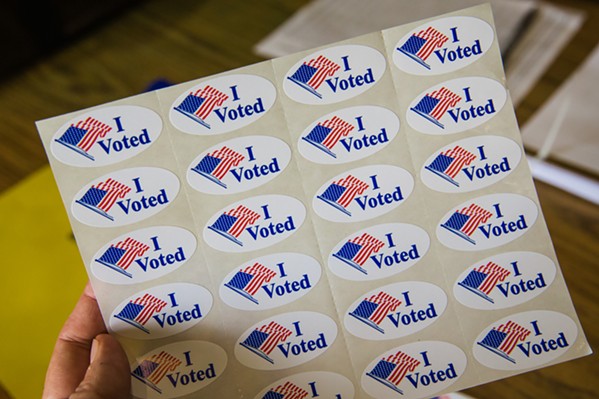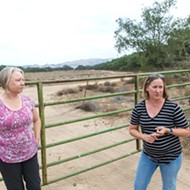SLO County opts out of listing measure supporters and opponents on voter ballots
By Bulbul Rajagopal[{
"name": "Newsletter Promo",
"id": "NewsletterPromo",
"class": "inlineCenter",
"insertPoint": "4",
"component": "15264767",
"requiredCountToDisplay": "0"
},{
"name": "Ad - Medium Rectangle CC01 - 300x250",
"id": "AdMediumRectangleCC01300x250",
"class": "inlineCenter",
"insertPoint": "8",
"component": "2963441",
"requiredCountToDisplay": "12"
},{
"name": "Ad - Medium Rectangle LC01 - 300x250",
"id": "AdMediumRectangleCC01300x250",
"class": "inlineCenter",
"insertPoint": "18",
"component": "2963441",
"requiredCountToDisplay": "22"
},{
"name": "Ad - Medium Rectangle LC09 - 300x250",
"id": "AdMediumRectangleLC09300x250",
"class": "inlineCenter",
"insertPoint": "28",
"component": "3252660",
"requiredCountToDisplay": "32"
}]
The San Luis Obispo County Board of Supervisors became the 34th in California to opt out of a Ballot Disclose Act requirement.
Joining a majority of its fellow 57 counties, SLO County will not be listing the supporters and opponents for county, city, district, and school measures on future election ballots.
The supervisors exercised the opt-out provision in a 3-2 vote—with 1st District Supervisor John Peschong and 5th District Supervisor Debbie Arnold dissenting—on May 21 after County Clerk-Recorder Elaina Cano filed the request for it. She cited cost and operational challenges.
"Additionally, there are concerns about politicizing the ballot by including supporters and opponents," she told New Times. "This could increase the potential for electioneering, especially if a current candidate listed on the ballot is also listed as a supporter or opponent of a measure. Such situations might lead to legal challenges due to perceived unfairness or ambiguity, as the registrar of voters would have to accept or deny abbreviations of supporters/opponents that may not be clear to voters."
Authored by Assemblymember Miguel Santiago (D-Los Angeles) and passed in 2022, the Ballot Disclose Act demands the ballot label include a condensed ballot title and summary and a 125-character list of supporters and opponents for each measure.
According to the SLO County staff report, the act's requirements aren't supported by any funding appropriation—it created an unfunded state mandate for California counties that already absorb most of the state and federal election costs. Cano said that SLO County would be set back $121,000 per election if it upholds the requirements of the Ballot Disclose Act.
"This includes expenses associated with printing larger ballots or additional ballot cards to accommodate the lists of supporters and opponents, as well as the costs of ballot design verification and proofing, which require additional staff time," she said.
The liberal majority on the Board of Supervisors—2nd, 3rd, and 4th District Supervisors Bruce Gibson, Dawn Ortiz-Legg, and Jimmy Paulding, respectively—voted in favor of opting out. Their support for not listing supporters and opponents lay in stark contrast to the League of Women Voters of California's backing of the act.
"By listing support and opposition, critical information about who is behind a ballot measure will be readily available on the face of the ballot itself," league President Carol Moon Goldberg wrote in a January 2022 letter to act author Santiago. "This convenience is especially important to voters whose primary exposure to ballot measures may have been from ads and mailers run by well-funded campaigns."
Gibson stressed at the May 21 meeting that voters would be faced with a lengthy ballot if supporters and opponents of measures were listed out. Cano confirmed to New Times that it would increase the space required for each measure by roughly 40 percent, likely requiring a second ballot card.
"I think it's interesting that all the Democrats came up with this idea," Ortiz-Legg said at the meeting. "Overall, just because somebody supports something, that can be very confusing as well. This leads to more mass confusion, as noted, and I really wish we didn't have as big a ballot as we already have."
Cano said voters can turn to the voter information guide for comprehensive details about measures and their supporters and opponents for the November general election.
"To those who say that not listing supporters and opponents hinders transparency, it can be argued that while the intention of providing more information to voters is commendable, the increased ballot complexity could lead to voter confusion and frustration," Cano told New Times. "Simply having this information printed on the official ballot does not provide the entire context of what the measure is, nor does it better inform the voter of the content of the measure."
Conservatives Peschong and Arnold aligned with the League of Women Voters. Arnold advocated listing out supporters and opponents of measures to sidestep "deceptive titles" of ballot measures.
"Sometimes, even the titles are really hard to understand," she said. "I always point to Prop. 47 ... that was the bill that legalized the $900 ceiling [for nonviolent property crimes] ... it went from a felony to a misdemeanor. ... Yet it was titled safe schools and neighborhoods." Δ
Latest in News
Readers also liked…
-

SLO police identify alleged driver who hit and killed couple
Dec 22, 2022 -

When the levee breaks: Oceano residents, county officials walk a tightrope of regulations to manage Arroyo Grande Creek, which some say led to the levee's failure in January
May 18, 2023 -

Cal Poly report highlights offshore wind's potential to spur green energy transition
Jun 8, 2023










